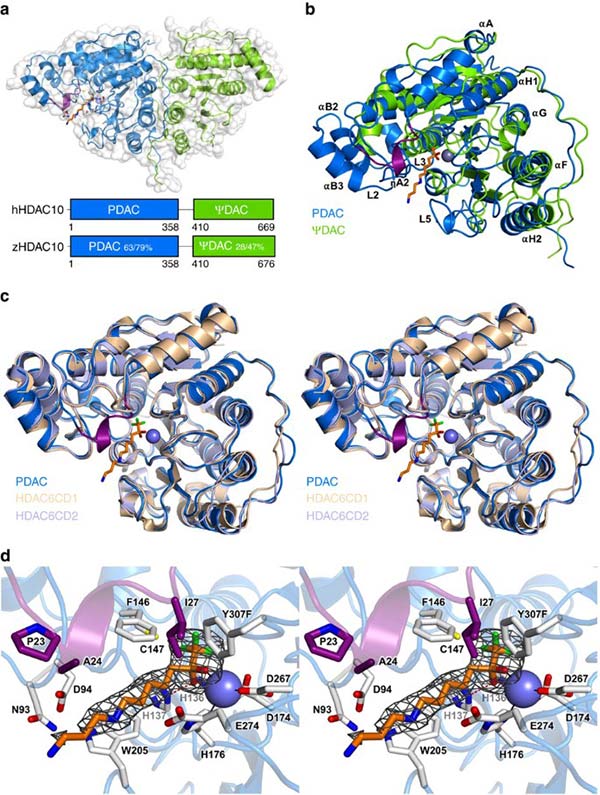What is HDAC10 Protein?
The HDAC10 protein, otherwise known as Histone Deacetylase 10, is a nucleolar enzyme that has been significantly linked to the pathogenesis of various diseases, particularly cancer. This protein has talents in diverse biological functions like gene expression, cell cycle progression, genomic stability, and more.
Discovery, Background, Gene Locus, and Protein Structure of HDAC10
Human histone deacetylase 10 (HDAC10) was first identified around 1999-2003. This discovery expanded the understanding of the Histone Deacetylases (HDACs) class of proteins. The HDAC proteins are known to remove acetyl groups from an ε-N-acetyl lysine on a histone, which allows the histones to wrap the DNA more tightly. This mechanism plays a crucial role in the regulation of gene expression.
HDAC10 belongs to the Class IIb of HDAC enzymes. Its gene locus is on chromosome 22q13.2 and encodes a protein comprising 649 amino acids. The structure of the HDAC10 protein comprises two catalytic domains, and the existence of oppositional residues in its active site suggests a preference for longer-chain polyamines, setting it apart from other histone deacetylases of the same family.

Fig1. Histone deacetylase 10 structure
Function of HDAC10 Protein
HDAC10 plays a dynamic role in the body, participating in a myriad of biological functions. Most notably, the actions of HDAC10 involve gene expression, cell cycle progression, and genomic stability, as it regulates the acetylation status of histones and other proteins. The protein acts as an enzyme that deacetylates lysine residues on the N-terminal part of the core histones (H2A, H2B, H3, and H4).
HDAC10 Protein Related Signal Pathway
The role of HDAC10 in signal pathways is linked to its impact on cell survival, especially in relation to autophagy. Autophagy acts as a quality control mechanism within cells, removing defected proteins or organelles. As HDAC10 enhances autophagy, it possibly influences several signal pathways associated with cellular health and homeostasis. This regulation might involve mTOR and Beclin1 signaling pathways that play a crucial role in cell survival and are associated with cancer development and treatment resistance.
HDAC10 Protein Related Diseases
Given its roles in gene expression regulation and cellular health signaling pathways, HDAC10 has been linked to the pathogenesis of various diseases, majorly cancer. An upregulation of HDAC10 has been found in various cancer types, including lung cancer, neuroblastoma, and acute myeloid leukemia, indicating its potential role as an oncogene. In contrast, down-regulation of HDAC10 in certain cancers suggests its probable function as a tumor suppressor, demonstrating its dual role in cancer progression.
HDAC10 Protein's Applications in Biomedical
The characterization of HDAC10 has led to several biomedical applications, primarily in the area of cancer treatment. HDAC10's active involvement in autophagy and cancer progression makes it a promising therapeutic target in oncology. Several drugs known as HDAC inhibitors, which can obstruct the action of HDAC10 and other related proteins, have been used in preclinical and clinical trials for treating various cancers. Furthermore, HDAC10 could be a valuable prognostic marker for tracking treatment response and patient outcome in specific cancer types.
In conclusion, HDAC10 stands as a crux in understanding cellular function and tackling various diseases, remarkably cancer. Its role in cell cycle regulation, gene expression, autophagy, and signal pathways makes it an attractive molecular target in disease treatment. While significant strides have been made in understanding and employing HDAC10 in the biomedical field, further research is necessary to reveal the entirety of its potential and function.
Our Featured Products
| Cat.No. | Product Name | Species | Source (Host) | Tag |
|---|---|---|---|---|
| HDAC10-393H | Active Recombinant Human HDAC10 protein, FLAG-tagged | Human | Insect Cell | FLAG |
| HDAC10-1354H | Active Recombinant Human HDAC10 (Active), GST-tagged | Human | Sf9 Insect Cell | GST |
| HDAC10-401H | Active Recombinant Human Histone Deacetylase 10, His-tagged | Human | Insect Cell | His |
| HDAC10-392H | Active Recombinant Human HDAC10 protein, GST/His-tagged | Human | Insect Cell | GST/His |
| HDAC10-3610HF | Recombinant Full Length Human HDAC10 Protein, GST-tagged | Human | In Vitro Cell Free System | GST |
| HDAC10-7527M | Recombinant Mouse HDAC10 Protein | Mouse | Mammalian Cell | His |
| Hdac10-3367M | Recombinant Mouse Hdac10 Protein, Myc/DDK-tagged | Mouse | HEK293T | Myc/DDK |
| HDAC10-4089M | Recombinant Mouse HDAC10 Protein, His (Fc)-Avi-tagged | Mouse | HEK293 | His (Fc)-Avi |
Reference
- Hai, Y., Shinsky, S. A., Porter, N. J., & Christianson, D. W. (2017). Histone deacetylase 10 structure and molecular function as a polyamine deacetylase. Nature Communications, 8(1), 1-9. https://doi.org/10.1038/ncomms15368

